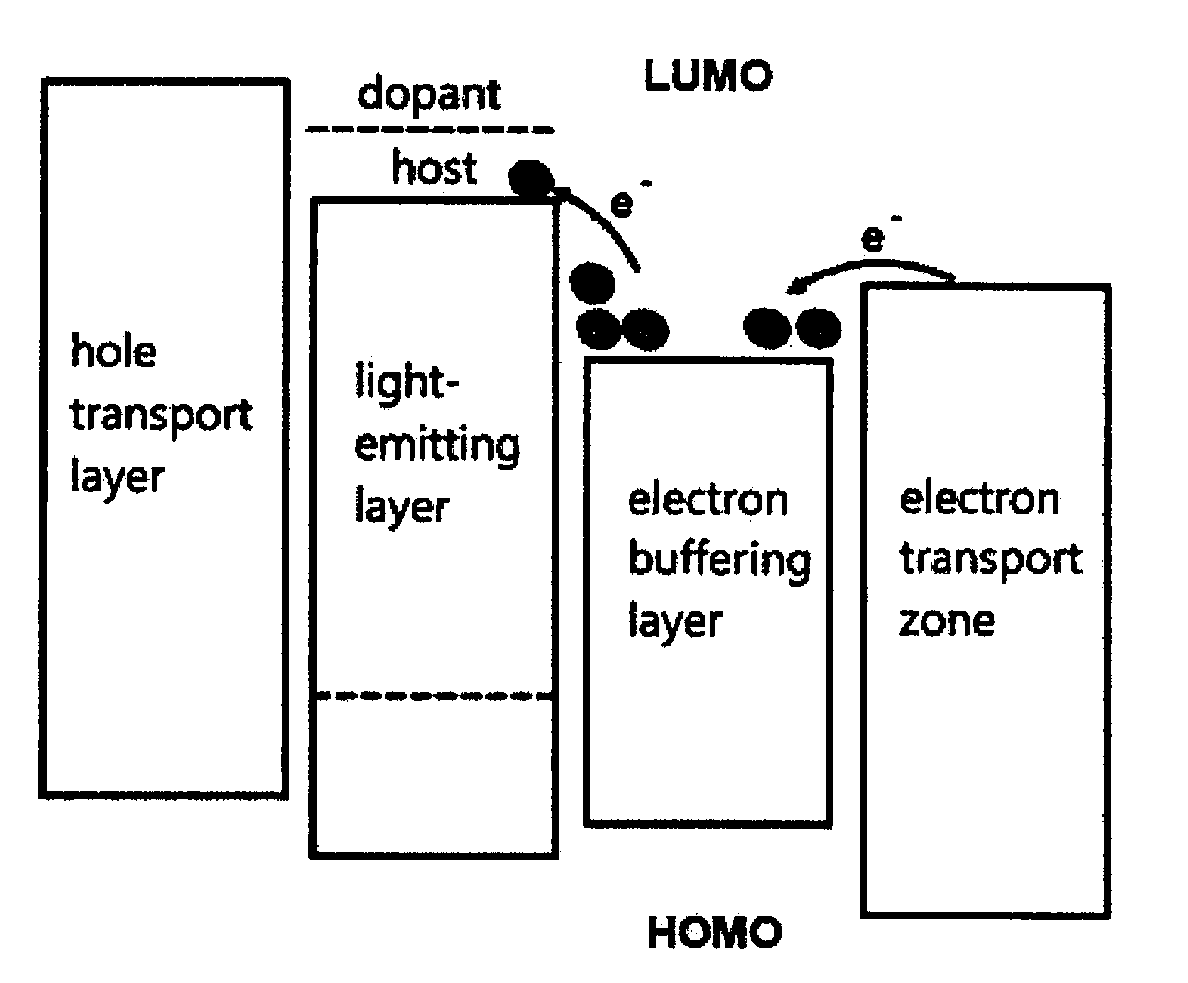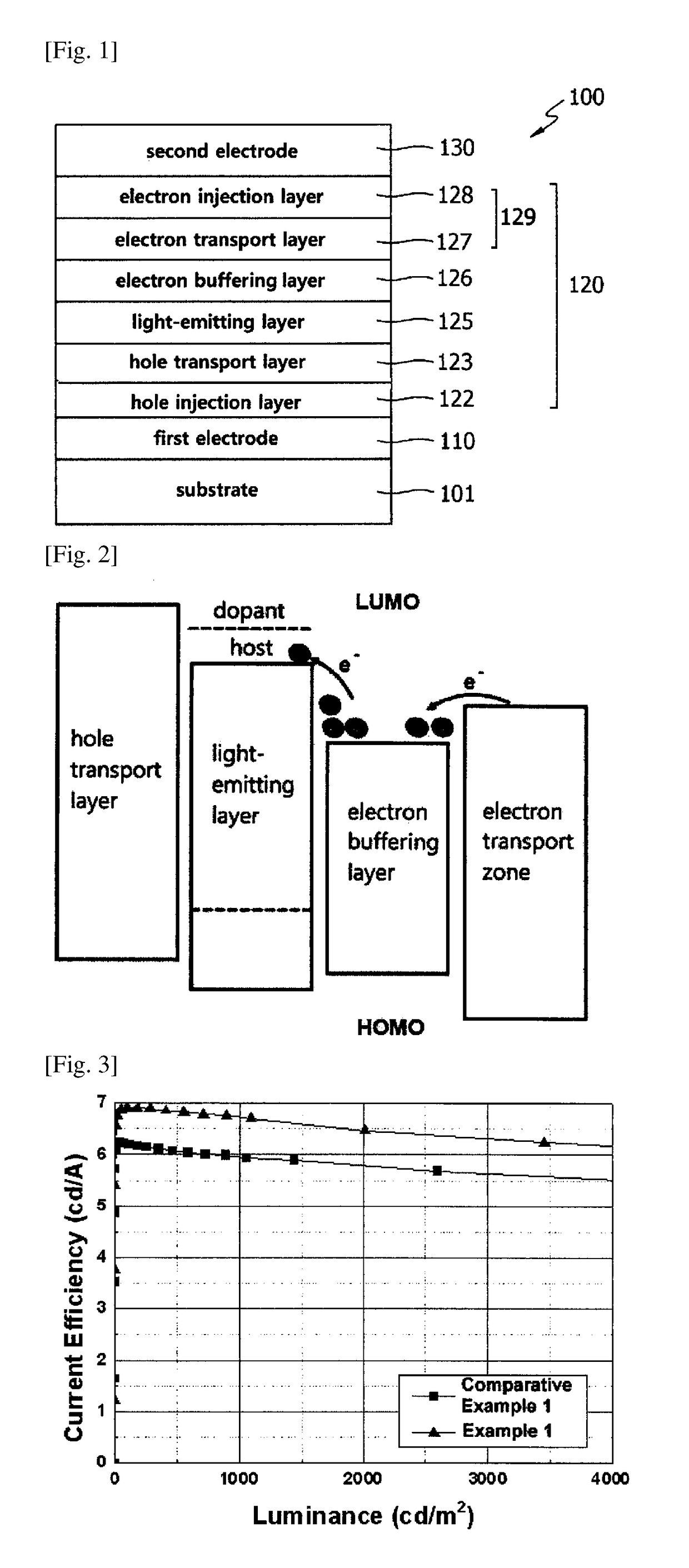Electron buffering materials, electron transport materials and organic electroluminescent device comprising the same
- Summary
- Abstract
- Description
- Claims
- Application Information
AI Technical Summary
Benefits of technology
Problems solved by technology
Method used
Image
Examples
example 1
[Example 1] Preparation of Compound C-24
[0118]
[0119]1) Preparation of Compound 1-1
[0120]After adding compound A (CAS: 1044146-16-8, 36 g, 124 mmol), 4-chloro-2-formylbenzene boronic acid (25.2 g, 136 mmol), tetrakis(triphenylphosphine)palladium (5.7 g, 5.0 mmol), sodium carbonate (33 g, 150 mmol), toluene (600 mL), EtOH (150 mL), and distilled water (150 mL) into a reaction vessel, the mixture was stirred at 140° C. for 3 hours. After completion of the reaction, the precipitated solid was washed with distilled water and MeOH. The obtained compound 1-1 was used in the next reaction without further purification.
[0121]2) Preparation of Compound 1-2
[0122]After introducing compound 1-1 (45.6 g, 130 mmol), (methoxymethyl)triphenylphosphonium chloride (74.3 g, 217 mmol), and tetrahydrofuran (1500 mL) into a reaction vessel, the reaction mixture was stirred for 5 minutes, and then potassium tert-butoxide (KOtBu) (1M in THF, 220 mL) was slowly added dropwise thereto at 0° C. The mixture was ...
example 2
[Example 2] Preparation of Compound C-1
[0127]
[0128]1) Preparation of Compound 2-1
[0129]After adding compound C (10 g, 29 mmol), bis(pinacolato)diborane (8.8 g, 34.8 mmol), tris(dibenzylideneacetone)dipalladium (Pd2(dba)3) (1.3 g, 1.45 mmol), 2-dicyclohexylphosphino-2′,6′-dimethoxybiphenyl(s-phos) (1.2 g, 2.9 mmol), potassium acetate (KOAc) (8.5 g, 87 mmol), and 1,4-dioxane (150 mL) into a reaction vessel, the mixture was then stirred at 140° C. for 3 hours. After completion of the reaction, the mixture was cooled to room temperature, and then was extracted with ethyl acetate. After the extracted organic layer was dried with magnesium sulfate, the solvent was removed therefrom with a rotary evaporator. The remaining product was purified by column chromatography to obtain compound 2-1 (10.4 g, yield: 82%).
[0130]2) Preparation of Compound C-1
[0131]After adding compound 2-1 (10 g, 23.8 mmol), 2-chloro-4,6-diphenyltriazine (CAS: 3842-55-5, 6.4 g, 23.8 mmol), tris(dibenzylideneacetone)dip...
example 3
[Example 3] Preparation of Compound C-17
[0132]
[0133]After adding compound C (8 g, 23.1 mmol), compound D (CAS: 1448296-00-1, 7.7 g, 23.1 mmol), tetrakis(triphenylphosphine)palladium (1.4 g, 1.19 mmol), K2CO3 (8.2 g, 60 mmol), toluene (90 mL), EtOH (30 mL), and distilled water (30 mL) into a reaction vessel, the mixture was stirred at 140° C. for 3 hours. After completion of the reaction, the precipitated solid was washed with distilled water and MeOH. The obtained compound was purified by column chromatography to obtain compound C-17 (8.7 g, yield: 77%).
PUM
 Login to View More
Login to View More Abstract
Description
Claims
Application Information
 Login to View More
Login to View More - R&D
- Intellectual Property
- Life Sciences
- Materials
- Tech Scout
- Unparalleled Data Quality
- Higher Quality Content
- 60% Fewer Hallucinations
Browse by: Latest US Patents, China's latest patents, Technical Efficacy Thesaurus, Application Domain, Technology Topic, Popular Technical Reports.
© 2025 PatSnap. All rights reserved.Legal|Privacy policy|Modern Slavery Act Transparency Statement|Sitemap|About US| Contact US: help@patsnap.com



